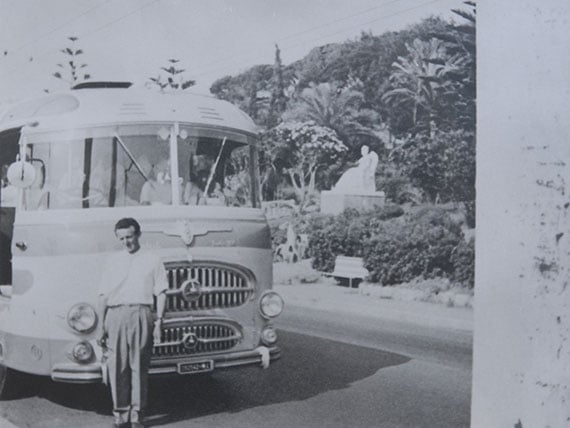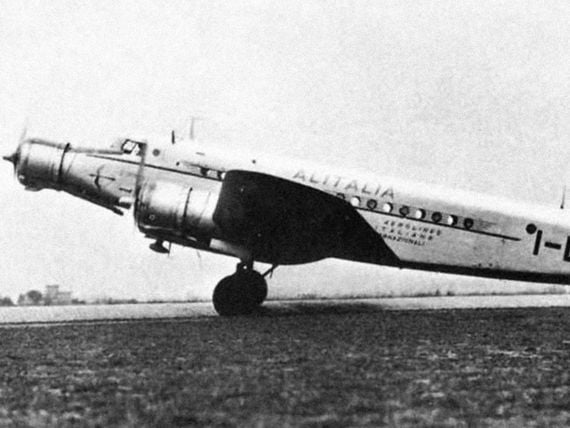
Ugo Frigerio, just after World War II ended, is involved in transporting building materials to the construction sites where the first reconstructions take place. Day after day, he encounters along the roads he travels many people on foot, only the lucky ones having a bicycle or a buggy.
From what he sees every day, he gets an idea: people need a means to get around and get around, and he intends to “solve the problem.” Often, he stops along the road and starts giving “rides”: at first he “disguises” one of the two trucks, with simple benches and a tarp. Shortly thereafter, thanks to his great skill as a mechanic, he transformed a Trerò truck into a torpedo and, armed with enthusiasm and confidence, set out with his dream: to get people moving, at a time when even the smallest movement represented a great difficulty and a huge expenditure of energy.
People in the village and surrounding areas began to get to know him: the first “private line” worker transport Alzate- Arosio-Carugo-Desio was born for the Targetti Company.
Toward the end of 1946, Frigerio Ugo & C. s.a.s. was born.
In mid-1948 he purchased his first real bus, foregoing the purchase of a hotel in Monte Carlo.
In those days a bus cost as little as a hotel.
In January 1949 his only son, Giancarlo, was born.
Over the next three years he did not stop for a moment. His reputation as a very good driver and excellent mechanic, combined with his incredible drive and certainty that he would complete every service entrusted to him, brought him many customers. Supported with great shrewdness and inexhaustible energy by his wife Enrica, who takes care of organizing a small l l office and accounting, they begin to see the first fruits of their labor.
From what he sees every day, he gets an idea: people need a means to get around and get around, and he intends to “solve the problem.” Often, he stops along the road and starts giving “rides”: at first he “disguises” one of the two trucks, with simple benches and a tarp. Shortly thereafter, thanks to his great skill as a mechanic, he transformed a Trerò truck into a torpedo and, armed with enthusiasm and confidence, set out with his dream: to get people moving, at a time when even the smallest movement represented a great difficulty and a huge expenditure of energy.
People in the village and surrounding areas began to get to know him: the first “private line” worker transport Alzate- Arosio-Carugo-Desio was born for the Targetti Company.
Toward the end of 1946, Frigerio Ugo & C. s.a.s. was born.
In mid-1948 he purchased his first real bus, foregoing the purchase of a hotel in Monte Carlo.
In those days a bus cost as little as a hotel.
In January 1949 his only son, Giancarlo, was born.
Over the next three years he did not stop for a moment. His reputation as a very good driver and excellent mechanic, combined with his incredible drive and certainty that he would complete every service entrusted to him, brought him many customers. Supported with great shrewdness and inexhaustible energy by his wife Enrica, who takes care of organizing a small l l office and accounting, they begin to see the first fruits of their labor.
HISTORICAL CONTEXT AND CURIOSITY

In 1946 a factory worker's salary is 10,000 Liras a month, a coffee costs 20 Liras.
On June 2, 1946, Italy becomes a republic. In a referendum more than 12 million Italians choose the republic, at the expense of the monarchy, which totals 10 million votes.
For the first time in Italy, women also have the right to vote.
The King of Italy, Umberto II, is exiled along with the entire family of the House of Savoy.
In 1948, the Italian Constitution comes into force.
The postwar period is that of the great reconstruction: also thanks to economic aid from the U.S., through the Marshall Plan, Italy began the repair and material rebuilding of houses and industries damaged during the conflict, and began to recover economically. These were the years of the so-called “economic miracle”: in this period the Gross Domestic Product grew by 6.3 percent, a record in the country's history, which saw consumption grow as a result.
1946 is an important year in the transportation industry. On April 23, a two-wheeled means of transportation was patented that would mark history and is still an icon of Italian-ness around the world: the Vespa. As the claims of the time read, “It is not a motorcycle, but rather a small two-wheeled car.” On Sept. 16, Alitalia-Aerolinee Internazionali Italiane was founded in Rome with private capital.
Also in 1946, French tailor Louis Reard presents in Paris a new swimsuit destined to radically and forever change the history of fashion: the bikini debuts.
In 1951, the Sanremo Italian Song Festival was born.
On June 2, 1946, Italy becomes a republic. In a referendum more than 12 million Italians choose the republic, at the expense of the monarchy, which totals 10 million votes.
For the first time in Italy, women also have the right to vote.
The King of Italy, Umberto II, is exiled along with the entire family of the House of Savoy.
In 1948, the Italian Constitution comes into force.
The postwar period is that of the great reconstruction: also thanks to economic aid from the U.S., through the Marshall Plan, Italy began the repair and material rebuilding of houses and industries damaged during the conflict, and began to recover economically. These were the years of the so-called “economic miracle”: in this period the Gross Domestic Product grew by 6.3 percent, a record in the country's history, which saw consumption grow as a result.
1946 is an important year in the transportation industry. On April 23, a two-wheeled means of transportation was patented that would mark history and is still an icon of Italian-ness around the world: the Vespa. As the claims of the time read, “It is not a motorcycle, but rather a small two-wheeled car.” On Sept. 16, Alitalia-Aerolinee Internazionali Italiane was founded in Rome with private capital.
Also in 1946, French tailor Louis Reard presents in Paris a new swimsuit destined to radically and forever change the history of fashion: the bikini debuts.
In 1951, the Sanremo Italian Song Festival was born.

